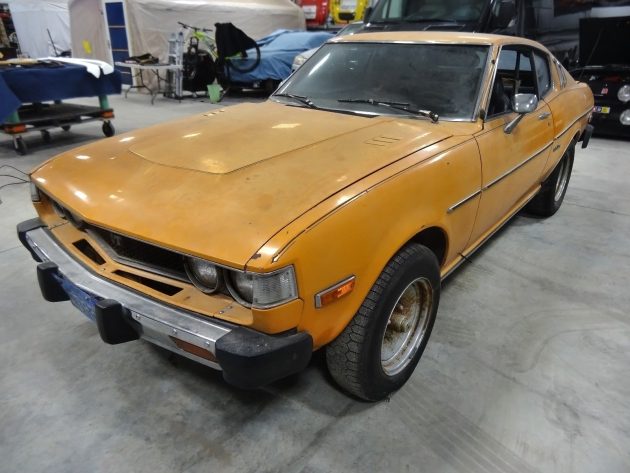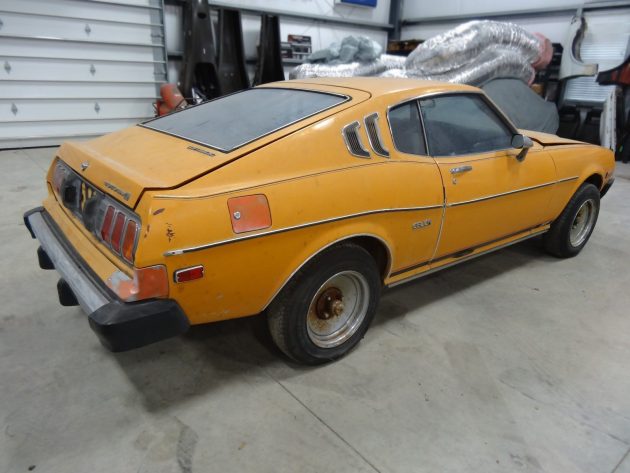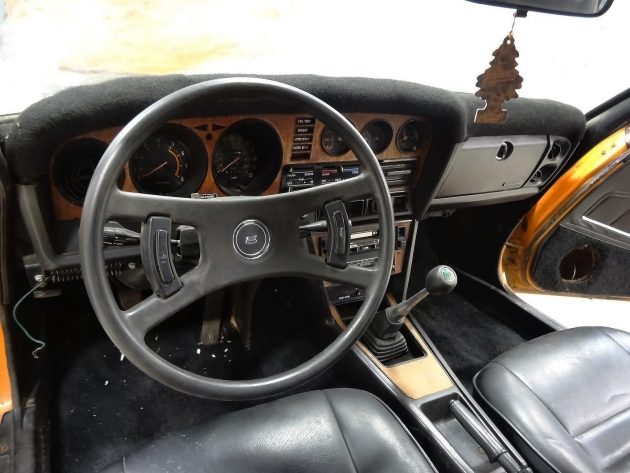It’s sometimes hard to believe how small most imports were in the 1970s and 80s. When did vehicles, in general, start supersizing with every new generation? Maybe since the beginning, I’m guessing, but it’s disappointing to see every make and model get little bigger with every redesign. I really like and miss small cars like this 1977 Toyota Celica GT. This solid-looking project car is listed on eBay with an unmet opening bid of $3,500 and no reserve after that point. It can be found in Waxhaw, North Carolina, just south of Charlotte.
It’s not always about me but.. ha, who am I kidding, it is always about me! No wait, I’m kidding with that part. Where were we, oh yeah, this great project Celica Liftback. I personally prefer the older cars – 1971-early-’72 like the one that Jeff showed us a few days ago. And, like that car, I also prefer the non-liftback Celica hardtop coupe bodystyle with a trunk on the Celica. If all was right with the world I would buy that blue ’72 and restore it back to like new condition. But, one look at the news tells us that all isn’t right with the world. That doesn’t mean that all isn’t right with this ’77 Celica GT Liftback. This is a very solid-looking blue-plate California example that the seller bought a year ago to restore but they have since mentally moved on to other projects. I sincerely know that feeling. Often times it’s the hunt, the chase, and the anticipation in finding old cars. Once they arrive, often looking much worse than the seller’s photos, descriptions, and even phone calls let on, it’s such a draining disappointment that all of the enthusiasm goes out the window and what seemed like a fun project turns into a can’t-get-rid-of-this-thing-soon-enough exercise.
There’s that huge liftback, and the hatch struts even work! This is one solid-looking car. I’ve already said that too often in this post, but these cars literally didn’t last long outside of bone-dry areas of the country/world. This looks like a solid, very worthy restoration/restomod project car. It looks like some overspray on that last photo showing the area behind the RR wheel, and the seller mentions that this car has “original paint”. I guess that doesn’t mean that it couldn’t have possibly been touched-up over the decades.
The interior even looks good, overall. I’m not sure what’s going on with the dash top, but other than that, and a few details, it looks good in there. The seats both front and back look good. The hatchback, or liftback, area has what looks like sun-cracked plastics here and there, so sourcing a few new pieces will be in order, unless they’re included in the stash of spare and new parts that the owner has available, for an additional price. The underside looks pretty solid, too, much more so than a Midwest or Northeast car would be after 40 years.
Oh oh, what’s up wit dat engine?! Well, this will turn into a parts hunt more than I thought. The seller says that “cylinder head has been removed at some point and the carburetor and rocker cover are missing. Everything else seems to be there.” Ouch. Well, most likely the next owner wouldn’t have just restored this car, they would have modified the original engine – which would have been a 20R 2.2L inline-four. That engine would have had around 96 hp, or 90 in California which is where this car is from. Are there any fans of these “big” first-generation Celicas? Big is a relative term for a 14.5-foot, 2,600-pound car.







Around about 1982/83 Toyota in Japan introduced a twin-cam engine to its range. The real performance one was a 2-litre engine with a twin-cam 16-valve head developed by Yamaha. It also featured fuel-injection. Those engines bolted into these Celicas with minimal modification. A friend of mine had one with that engine fitted and it went really hard for a 4-pot, but was still ok with being driven sedately. If you could get hold of one of those engines it would make a sensible upgrade.
I had the same Celica in my youth and was quite happy with it indeed . The 20 R engine is one of the best developed. I had at the time ordered a header from Japan and added a Weber carburetor. This little car got me in a lot of trouble due to my need for speed. After these two simple modifications the Celica would bark every gear and would out run most factory Toyota 6 cylinder vehicles. The top speed was around 135 MPH but that took a little to get there after 100 MPH . What a fun car it was. Thanks for the memory.
Thanks to Adam & Scott for the info on real Toyota engine upgrades. The story I remember is that the Japanese were very enamored of ’69-’70 Mustang fastbacks and styled this car to resemble them, at about 75% scale. The color is very age-appropriate. Nice find.
My mother owned this same make, model and color. It had very custom pin striping done by the dealer in Auburn, WA. I learned to drive in that 5 speed. It would do 70 in second gear. It seemed heavy for such a small car. Would have kept it forever, but Dad got in an accident wih it. Great, great car, may try to find one now. Great memories.
Do like these…really…and the earlier one’s as well….wrenched on a one owner for a few years…dang she was a pretty girl then….and a cancer survivor some 40yrs later…!
This has always been my favorite Celica. I love the lines and the look. This one would be a fun reconditioning.
I never noticed how many styling cues the Celica borrowed from the late 1960s Mustangs fastbacks.
The model preceding this one used styling cues from the 69 Camaro. Then came the mini mustang. I was always amazed that not many people saw the resemblance. There were a lot of foreign mini American cars like the Opel Gt mini 68 Vette, and the 60s Vauxhall that resembled a 57 Chevy. Volvo also made a sporty number that resembled an Austin Martin. I love these Minime cars.
These are fun little cars. Still kicking myself for practically GIVING TWO of these away about 15 years ago. (!) I bought a piece of land adjacent to mine that the previous owner left one of these on. It ran but the interior was rough and I don’t know if he had a title or not, but if he did, he didn’t provide it to me. I wasn’t sure what to do with it until one day when I was visiting my dad were he was working near Navasota Tx. I saw one sitting in a pasture next to a house. I knocked on the door and found out that the owner quit driving ti due to the front suspension being worn out from washboard gravel roads and “not being worth fixing” and it could be bought for $300. It was a 1976, pretty clean, original red paint and white decals, with only one rust spot around 1/2″ diameter at the lower corner of the rear glass. I swapped the whole front suspension from the “parts” car into the 76 , rebuilt the carb and drove it to work a while. I charged the AC and later replaced the water pump. A good compound and wax did wonders for the paint. The parts car had newer factory Celica alloys and decent tires (15″?) that I swapped in place of the stock steel wheels and caps/ rings. I drove it for a year or so and a guy at a gas station offered me $3k for it. I was a broke apprentice electrician and it was a third car, so I jumped on the chance. Oy….
As a Mustang guy, I really liked them because of the taillights. Very cool. A friend of mine had a ‘red ’75 and I have always liked them…
It is amazing how large today’s small cars have become
My Volvo 1800ES and Lancia Beta are Ford Fiesta-sized, at best.
Celicas are fun cars, and this looks like a good basis for an easy project that will almost certainly appreciate with time
Just sold this all original one owner, non-running GT for $3000.00 to a guy in South America. Just saying……..
AKA the Nipstang.
Cool Pat, very cool… I like it ‘NipStangf’
I really like this one. Wondering how hard the parts are to get by
Lovely looking 1st generation Toyota Celica. I like the coupe version over the liftback, but this is nice. 🙂